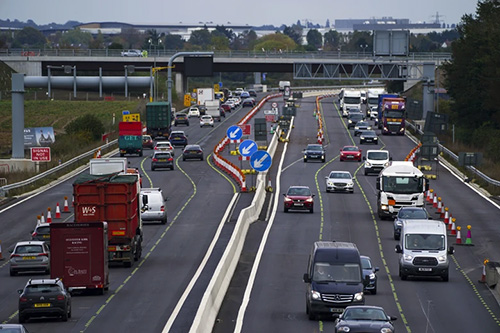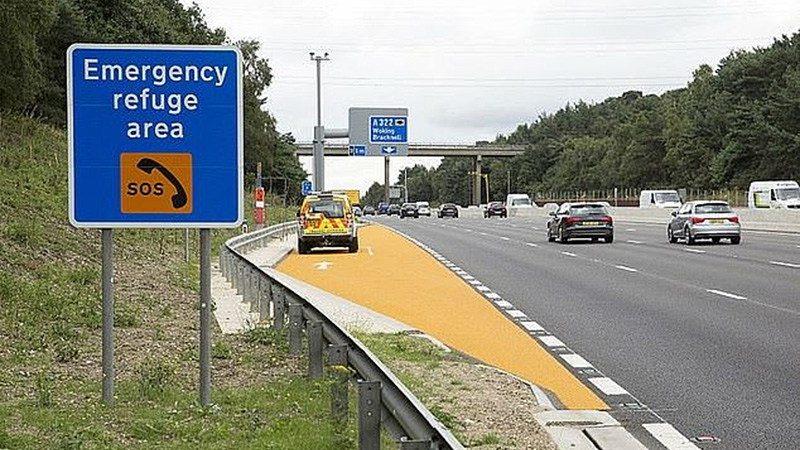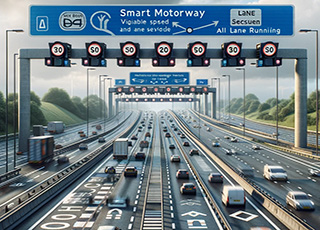Smart motorways have become a topic of significant discussion and debate among drivers in the UK. Despite constituting only around 13% of England’s motorway network, these highways have drawn attention due to concerns over their design, safety, and operational procedures. While recent decisions by the government to halt new smart motorway projects have sparked further debate, it’s crucial for drivers to understand how to navigate and utilise existing smart motorways effectively and safely.
Understanding Smart Motorways
Smart motorways represent a transformative approach to modernising the highway infrastructure to meet the demands of growing traffic volumes and urbanisation. These highways are not just conventional roadways; they are dynamic corridors designed to adapt to fluctuating traffic conditions and optimise the use of available space. At their core, smart motorways leverage cutting-edge traffic management technologies to enhance efficiency, safety, and reliability for drivers.
 One of the hallmark features of smart motorways is their ability to repurpose the hard shoulder, traditionally reserved for emergencies, into a fully operational lane during periods of peak congestion. This innovative approach effectively increases capacity without the need for costly and disruptive construction projects to widen the roadway. By utilising every available inch of pavement, smart motorways can accommodate surges in traffic volume while maintaining smooth and consistent flow.
One of the hallmark features of smart motorways is their ability to repurpose the hard shoulder, traditionally reserved for emergencies, into a fully operational lane during periods of peak congestion. This innovative approach effectively increases capacity without the need for costly and disruptive construction projects to widen the roadway. By utilising every available inch of pavement, smart motorways can accommodate surges in traffic volume while maintaining smooth and consistent flow.
Moreover, smart motorways employ variable speed limits as a proactive measure to regulate traffic speed and reduce congestion. Unlike traditional fixed speed limits, which may not adequately address changing conditions, variable speed limits can be adjusted in real-time based on factors such as traffic volume, weather conditions, and accidents. This adaptive approach ensures that drivers can travel at safe and efficient speeds, mitigating the risk of accidents and minimising delays.
Types of Smart Motorways
There are three primary types of smart motorways:
All-lane running (ALR) schemes permanently convert the hard shoulder into a running lane, with closures signalled by red X signs during incidents. Mandatory speed limits are displayed on overhead signs and enforced by speed cameras.
Dynamic hard shoulder running schemes activate the hard shoulder as a running lane during peak traffic periods, with overhead signs indicating lane status and speed limits.
Controlled motorways retain the hard shoulder and utilise variable speed limits to manage traffic flow, with speed limits enforced by cameras.
Safety Concerns and Regulations
Despite the intended benefits of smart motorways, safety concerns persist among drivers. Key issues include the absence of a permanent hard shoulder, which some argue poses risks during breakdowns and emergencies. While Highways England highlights improvements in journey reliability and accident reduction, public perception remains cautious.
Rules and Penalties
In adhering to the regulations governing smart motorways, drivers must observe standard road rules, which include compliance with designated speed limits and appropriate lane usage. Speeding fines are rigorously enforced through a network of cameras strategically positioned along the roadway, capable of capturing violations in real-time. These fines serve as a deterrent to discourage drivers from exceeding the prescribed speed limits, thereby promoting safer driving behaviours.
Additionally, drivers must remain vigilant and responsive to red X signs displayed on overhead gantries, indicating lane closures due to incidents or hazards ahead. Failure to heed these warnings can result in automatic fines and penalty points on the driver’s licence. Such penalties underscore the importance of adhering to traffic regulations and exercising caution while navigating smart motorways.
Emergency Procedures
In the case of breakdowns or accidents on smart motorways, it’s essential for drivers to be aware of and utilise Emergency Refuge Areas (ERAs) for their safety and the safety of others. These designated areas are strategically spaced along the motorway and are easily identifiable by prominent signs and orange paint, making them easily accessible for drivers in need of assistance.
 Upon encountering a situation requiring the use of an ERA, drivers should promptly steer their vehicle towards the nearest refuge area and switch on their hazard warning lights to signal their distress to other motorists. Once safely parked within the designated area, occupants should exit the vehicle from the passenger side and stand behind the protective crash barrier, away from the flow of traffic.
Upon encountering a situation requiring the use of an ERA, drivers should promptly steer their vehicle towards the nearest refuge area and switch on their hazard warning lights to signal their distress to other motorists. Once safely parked within the designated area, occupants should exit the vehicle from the passenger side and stand behind the protective crash barrier, away from the flow of traffic.
Following these procedures ensures the safety of both the stranded driver and any passengers, minimising the risk of further accidents or injuries. Additionally, drivers should use the emergency telephone provided in the ERA to contact the relevant authorities, such as Highways England, for assistance. This ensures that appropriate measures are taken to resolve the situation swiftly and effectively.
Ongoing Debate and Future Developments
The ongoing debate surrounding smart motorways underscores the importance of continuously evaluating and improving these innovative traffic management systems. While some stakeholders express concerns about safety and the adequacy of emergency provisions, others emphasise the benefits of increased capacity and reduced congestion. Despite differing opinions, it is clear that smart motorways represent a significant component of modern highway infrastructure in England.
To address safety concerns and improve the effectiveness of smart motorways, ongoing efforts are being made to implement enhancements and updates. One such initiative involves the retrofitting of additional Emergency Refuge Areas (ERAs) along existing smart motorway corridors. By increasing the frequency of these designated safe zones, authorities aim to provide motorists with more accessible options for seeking refuge in the event of breakdowns or emergencies.
Furthermore, advancements in monitoring technologies, such as radar-based systems for detecting stationary vehicles, are being explored to enhance the responsiveness of smart motorway operations. These technologies have the potential to improve incident detection and response times, thereby enhancing overall safety and mitigating risks associated with breakdowns and accidents.
Finally
Smart motorways represent a complex and evolving aspect of modern transportation infrastructure. While they offer potential benefits in terms of increased capacity and reduced congestion, safety concerns remain paramount. By understanding the operational principles, regulations, and emergency procedures associated with smart motorways, drivers can navigate these highways with confidence and contribute to safer roads for all. Ongoing efforts to address safety issues and enhance operational efficiency will be critical in shaping the future of smart motorways in the UK.



Recent Comments